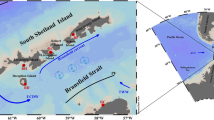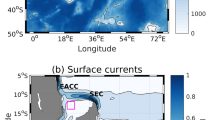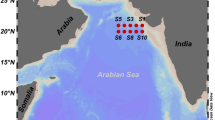Abstract
The factors controlling phytoplankton bloom development in the marginal ice zone of the northwestern Weddell Sea were investigated during the EPOS (Leg 2) expedition (1988). Measurements were made of physical and chemical processes and biological activities associated with the process of ice-melting and their controlling variables particularly light limitation mediated by vertical stability and ice-cover, trace metal deficiency and grazing pressure. The combined observations and process studies show that the initiation of the phytoplankton bloom, dominated by nanoplanktonic species, was determined by the physical processes operating in the marginal ice zone at the time of ice melting. The additional effects of grazing pressure by protozoa and deep mixing appeared responsible for a rather moderate phytoplankton biomass (4 mg Chla m−3) with a relatively narrow geographical extent (100–150 km). The rôle of trace constituents, in particular iron, was minor. The importance of each factor during the seasonal development of the ice-edge phytoplankton bloom was studied through modelling of reasonable scenarios of meteorological and biological forcing, making use of a one-dimensional coupled physicalbiological model. The analysis of simulations clearly shows that wind mixing events — their duration, strength and frequency — determines both the distance from the iceedge of the sea ice associated phytoplankton bloom and the occurrence in the ice-free area of secondary phytoplankton blooms during the summer period. The magnitude and extent of the ice-edge bloom is determined by the combined action of meteorological conditions and grazing pressure. In the absence of grazers, a maximum ice-edge bloom of 7.5 mg Chla m−3 is predicted under averaged wind conditions of 8 m s−1. Extreme constant wind scenarios (4–14 m s−1) combined with realistic grazing pressure predict maximum ice-edge phytoplankton concentrations varying from 11.5 to 2 mg Chla m−3. Persistent violent wind conditions (≥ 14 m s−1) are shown to prevent blooms from developing even during the brightest period of the year.
Similar content being viewed by others
References
Ackley SG (1981). A review of sea-ice weather relationships in the Southern Hemisphere. In: Sea level, ice and climate change. Proceedings of the Canberra Symposium, IAHS Publ., 136:127–159
Baar HJW de, Buma AGJ, Nolting RF, Cadée GC, Jacques G, Tréguer, P (1990). On iron limitation of the Southern Ocean: Experimental observations in the Weddell and Scotia Sea. Mar Ecol Progr Ser 65:105–122
Becquevort S, Mathot S, Lancelot C (1992). Interactions in the microbial community of in the marginal ice zone of the northwestern Weddell Sea through size distribution analysis, Polar Biol 12:211–218
Björnsen PK, Kuparinen J (1991). Growth and herbivory by heterotrophic dinoflagellates in the Southern Ocean studied by microcosm experiments. Mar Biol 109:397–405
Buma AGJ, Baar HJW de, Nolting RF, Van Bennekom AJ (1991). Metal enrichment experiments in the Weddell Sea: Effects of Fe and Mn on various plankton communities. Limnol Oceanogr 36:1865–1878
Coale KH (1991). The effects of Iron, Manganese, Copper and Zinc Enrichments on Productivity and Biomass in the Subarctic Pacific, Limnol Oceanogr 36:1851–1864
Cohen D, Parnas H (1976). An optimal policy for the metabolism of storage materials in unicellular algae. J Theor Biol 56:1–18
Comiso JC, Maynard NG, Smith WO, Sullivan CW (1990). Satellite ocean color studies of Antarctic ice edges in summer and autumn. J Geophys Res C6:9481–9496
Deacon G (1984). The Antarctic circumpolar ocean. Studies in Polar Research, Cambridge University Press, p 180
El-Sayed, SZ (1984). Productivity of the Antarctic waters: a reappraisal. In: Holm-Hansen O, Bolis L, Gilles R (eds) Marine Phytoplankton and productivity. Springer Berlin Heidelberg, New York pp 19–34
Garrison DL, Buck KR, Fryxell GA (1987). Algal assemblages in Antarctic pack ice and in ice-edge plankton. J Phycol 23:564–572
Goeyens L, Sorensen F, Tréguer P, Morvan J, Panouse M, Dehairs F (1991). Spatiotemporal variability of inorganic nitrogen stocks and uptake fluxes in the Scotia-Weddell Confluence area during November and December 1988, Mar Ecol Prog Ser 77(1):7–19
Goeyens L, Dehairs F (1993). Seasonal fluctuation of export and recycled production in different subareas of the Southern ocean. Belgian Scientific Research Programme on Antarctica. Scientific results of phase II (in press)
Hayes PK, Whitaker TM, Fogg GE (1984). The distribution and nutrient status of phytoplankton in the Southern Ocean between 20° and 70°W. Polar Biol 3:153–165
Hempel G (1985). On the biology of polar seas, particularly the Southern Ocean. In: Gray JS, Christiansen ME (eds), Marine biology of polar regions and effects of stress on marine organisms. J. Wiley & Sons, pp 3–33
Hempel I, Schalk PH, Smetacek V (1989). The expedition Antarktis VII/3 (EPOS Leg 2) of RV “Polarstern“ in 1988/1989. Ber Polarforsch 47–56
Hewes CD, Holm-Hansen O, Sakshaug E (1985). Alternate carbon pathways at lower trophic levels in the Antarctic food web. In: Siegried WR, Condy PR, Laws RM (eds) Antarctic nutrient cycles and food webs, pp 237–283
Hewes CD, Sakshaug E, Reid FM, Holm-Hansen O (1990) Microbial autrotrophic and heterotrophic eucaryotes in Antarctic waters: Relationships between biomass and chlorophyll, adenosize triphosphate and particulate organic carbon. Mar Ecol Prog Ser 63:27–35
Holm-Hansen O, El-Sayed SZ, Franceschini GA, Cuhel RL (1977). Primary production and the factors controlling phytoplankton growth in the Southern Ocean. In Adaptations within Antarctic Ecosystems. Proceedings 3rd SCAR symposium on Antarctic Biology, pp 11–50
Jacques G, Panouse M (1991). Biomass and composition of size fractionated phytoplankton in the Weddell Sea Confluence area. Polar Biol 11:315–328
Lancelot C, Billen G, Mathot S (1989) Ecophysiology of phytoplankton and bacterioplankton growth in the Southern Ocean. In: Belgian Scientific Research Programme on Antarctica. Scientific Results of Phase One (Oct. 85–Jan. 89). Vol. 1: Plankton Ecology pp 1–97
Lancelot C, Veth C, Mathot S (1991) Modelling ice-edge phytoplankton bloom in the Scotia-Weddell sea sector of the Southern Ocean during spring 1988. J Mar Syst 2:333–346
Magas B, Svansson A (1989). Optics. In: Hempel I, Schalk PH, Smetacek V (eds) The expedition Antarktis VII/3 (EPOS Leg 2) of RV “Polarstern“ in 1988/1989. Berichte zur Polarforschung pp 20–24
Marschall HP (1988) The overwintering strategy of Antarctic krill under the pack-ice of the Weddell Sea. Polar Biol 9:129–135
Martin JH, Fitzwater SE (1988). Iron deficiency limits phytoplankton growth in the north-east Pacific subarctic. Nature 331:341–343
Martin JH, Gordon RM, Fitzwater SE (1990). Iron in Antarctic waters, Nature 345:156–158
Martin JH, Fitzwater SE, Gordon RM (1990). Iron deficiency limits phytoplankton growth in Antarctic waters, Global Biogeochemical Cycles 4:5–12
Mathot S, Becquevort S, Lancelot C (1992). Microbial communities from sea-ice and adjacent water column at the time of ice melting in the north western part of the Weddell Sea. Polar Res 10(1):268–275
Mathot S, Dandois JM, Lancelot C (1992). Gross and net primary production in the Scotia-Weddell Sea during spring 1988, Polar Biol 12:321–332
Mitchell BG, Holm Hansen O (1991). Observations and modelling of the Antarctic phytoplankton crop in relationship to mixing depth, Deep-Sea Res 38(8/9A):981–1008
Mitchell BG, Brody EA, Holm-Hansen O, Mc Clain C, Bishop J (1991). Light limitation of phytoplankton biomass and macronutrient utilization in the Southern Ocean. Limnol Oceanogr 36(8):1662–1677
Morel FMM, Rueter JG, Price NM (1991). Iron nutrition of phytoplankton and its possible importance in the ecology of ocean regions with high nutrient and low biomass. Oceanography, 4(2):56–61
Nelson DM, Smith WO, Gordon LI, Huber BA (1987). Spring distribution of density, nutrients and phytoplankton biomass in the ice-edge zone of the Weddell-Scotia Sea. J Geophys Res 92(C7):7181–7190
Nelson DM, Smith WO Jr (1991). Sverdrup revised: critical depths, maximum chlorophyll levels and the control of Southern Ocean productivity by irradiance-mixing regime. Limnol Oceanogr 36(6):1650–1661
Nelson DM, Tréguer P (1992). Role of silicon as a limiting nutrient to Antarctic diatoms: evidence from kinetics studies in the Ross Sea ice-edge zone. Mar Ecol Prog Ser 80:255–264
Nolting RF, Bennekom AJ van, Masson A (1991). Cadmium, copper and iron in the Scotia Sea, Weddell Sea and Weddell/Scotia Confluence (Antarctica), Marine Chemistry
Riebesell U, Schloss I, Smetacek V (1991). Aggregation of algae released from melting sea ice: Implication for seeding and sedimentation. Polar Biol 11:239–248
Sakshaug E, Slagstad D, Holm-Hansen O (1991). Factors controlling the development of phytoplankton blooms in the Antarctic Ocean — a mathematical model. Mar Chem 35:259–271
Schalk PH (1990) Biology activity in the Antarctic zooplankton community. Polar Biol 10:405–411
Smetacek V, Scharek R, Nothig EM (1990). Seasonal and regional variation in the pelagial and its relationship to the life history cycle of krill. In Kerny R, Hempel G (eds) Antarctic Ecosystems: Ecological change and conservations Springer, Berlin Heidelberg, pp 103–114
Smith WO Jr, Nelson DM (1985). Phytoplankton bloom produced by a receding ice-edge in the Ross Sea: Spatial coherence with the density field, Science 227:163–165
Smith WO Jr, Nelson DM (1986). The importance of ice-edge phytoplankton blooms in the Southern Ocean., BioScience 36:251–257
Smith WO Jr, Nelson DM (1990). Phytoplankton growth and new production in the Weddell Sea marginal ice zone in the austral spring and autumn. Limnol Oceanogr 35:809–821
Stretch JJ, Hammer PP, Hammer WM, Michel WC, Cook J Sullivan CW (1988). Foraging behavior of Antarctic krillEuphausia superba on sea ice microalgae. Mar Ecol Progr Ser 44:131–139
Tréguer P, Le Corre P (1975). Manuel d'analyses automatiques des sels nutritifs par Auto Analyser II Technicon. Université de Bretagne Occidentale, Brest
Van Bennekom J, Estrada M, Goeyens L, Magas B, Masson A, Morvan J, Tréguer P, Svansson A, Veth C (1989). Distribution of nutrients in surface, subsurface and deep layers. In: Hempel I, Schalk PH, Smetacek V (eds) The Expedition Antarktis VII/3 (EPOS Leg 2) of RV “Polarstern“ in 1988/1989. Ber Polarsforsch pp 47–56
Van Franeker JA (1989). Sea ice conditions. In: Hempel I, Schalk PH, Smetacek V (eds), The Expedition Antarktis VII/3 (EPOS Leg 2) of RV “Polarstern“ in 1988/89. Berichte Polarforschung pp 10–13
Veth C (1991). The evolution of the upper water layer in the marginal ice zone, austral spring 1988, Scotia-Weddel Sea, J Mar Syst 2:451–464
Veth C, Lancelot C, Ober S (1992). On processes determining the vertical stability of surface waters in the marginal ice zone of the north-western Weddell Sea and their relationship with phytoplankton bloom development. Polar Biol 12:237–243
Westerlund S, Öhman P (1991). Iron in the water column of the Weddell Sea, Marine Chemistry 35:199–217
Author information
Authors and Affiliations
Rights and permissions
About this article
Cite this article
Lancelot, C., Mathot, S., Veth, C. et al. Factors controlling phytoplankton ice-edge blooms in the marginal ice-zone of the northwestern Weddell Sea during sea ice retreat 1988: Field observations and mathematical modelling. Polar Biol 13, 377–387 (1993). https://doi.org/10.1007/BF01681979
Received:
Accepted:
Issue Date:
DOI: https://doi.org/10.1007/BF01681979




